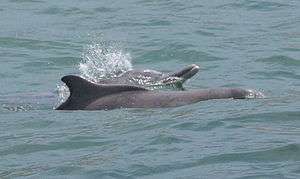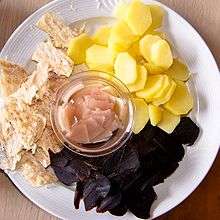Marine mammals as food

Historically, marine mammals were hunted by coastal aboriginal humans for food and other resources. The effects of this were only localised as hunting efforts were on a relatively small scale. Later large scale commercial hunting was developed. Marine mammals were heavily exploited, leading to the extinction of some species.
Today, the exploitation of marine mammals is much reduced. However, a 2011 study found that the number of humans eating marine mammals is increasing.[1] According to the study’s lead author, Martin Robards, "Some of the most commonly eaten animals are small cetaceans like the lesser dolphins... That was a surprise since only a decade ago there had only been only scattered reports of this happening".[2] Moreover, fish oil supplement studies have failed to support claims of preventing heart attacks or strokes.[3][4][5]
History
Historically, marine mammals were hunted by coastal aboriginal humans for food and other resources. The effects of this were only localised as hunting efforts were on a relatively small scale.[6] Later, commercial hunting was developed and marine mammals were heavily exploited. This led to the extinction of the Steller's Sea Cow and the Caribbean monk seal.[6] Today, populations of species that were historically hunted, such as blue whales Balaenoptera musculus and B. m. brevicauda), and the North Pacific right whale (Eubalaena japonica), are much lower compared to their pre-exploited levels.[7] Because whales generally have slow growth rates, are slow to reach sexual maturity, and have a low reproductive output, population recovery has been very slow.[8] Despite the fact commercial whaling is generally a thing of the past since the passage of the International Whaling Commission’s (IWC) moratorium on commercial whaling, a number of marine mammals are still subject to direct hunting. The only remaining commercial hunting of whales is by Norway where several hundred northeastern North Atlantic minke whales are harvested each year, and Iceland, which takes approximately 150 North Atlantic fin whales and less than 50 minke whales each year. Japan also harvests several hundred Antarctic and North Pacific minke whales each year under the guise of scientific research.[7] However, the illegal trade of whale and dolphin meat is a significant market in some countries.[9] Seals and sealions are also still hunted in some areas such as Canada.
Overview


For thousands of years, people native to the Alaskan Arctic have depended on whale meat. The meat is harvested from legal, non-commercial hunts that occur twice a year in the spring and autumn. The meat is stored and eaten throughout the winter.[10] Coastal Alaska Natives divided their catch into 10 sections. The fatty tail, considered to be the best part, went to the captain of the conquering vessel, while the less-desired sections were given to his crew and others that assisted with the kill.[11] The skin and blubber (muktuk) taken from the bowfin, beluga, or narwhal is also valued, and is eaten raw or cooked. Whaling has also been practiced in the Faroe Islands in the North Atlantic since about the time of the first Norse settlements on the islands. Around 1000 Long-finned pilot whales are still killed annually, mainly during the summer.[12]
In recent years Japan resumed hunting for whales, which they call "research whaling". Japanese research vessels refer to the harvested whale meat as incidental byproducts resulting from lethal study. In 2006, 5,560 tons of whale meat was sold for consumption.[13] In modern-day Japan, two cuts of whale meat are usually distinguished: the belly meat and the tail or fluke meat. Fluke meat can sell for $200 per kilogram, over three times the price of belly meat.[11] Fin whales are particularly desired because they are thought to yield the best quality fluke meat.[14]
In some parts of the world, such as Taiji in Japan and the Faroe Islands, dolphins are traditionally considered as food, and are killed in harpoon or drive hunts.[15] Dolphin meat is consumed in a small number of countries world-wide, which include Japan[16] and Peru (where it is referred to as chancho marino, or "sea pork").[17] While Japan may be the best-known and most controversial example, only a very small minority of the population has ever sampled it.
Dolphin meat is dense and such a dark shade of red as to appear black. Fat is located in a layer of blubber between the meat and the skin. When dolphin meat is eaten in Japan, it is often cut into thin strips and eaten raw as sashimi, garnished with onion and either horseradish or grated garlic, much as with sashimi of whale or horse meat (basashi). When cooked, dolphin meat is cut into bite-size cubes and then batter-fried or simmered in a miso sauce with vegetables. Cooked dolphin meat has a flavor very similar to beef liver.[18] Dolphin meat is high in mercury, and may pose a health danger to humans when consumed.[19]
Ringed seals were once the main food staple for the Inuit. They are still an important food source for the people of Nunavut[20] and are also hunted and eaten in Alaska. Seal meat is an important source of food for residents of small coastal communities.[21] Meat is sold to the Asian pet food market; in 2004, only Taiwan and South Korea purchased seal meat from Canada.[22] The seal blubber is used to make seal oil, which is marketed as a fish oil supplement. In 2001, two percent of Canada's raw seal oil was processed and sold in Canadian health stores.[23] There has been virtually no market for seal organs since 1998.[21] Archaeological evidence indicates that for thousands of years, indigenous peoples have also hunted sea otters for food and fur.[24]
-

Indian whalers removing strips of flesh from a whale carcass at Neah Bay, Washington
-

Whale meat on sale at Tsukiji fish market, Tokyo
-

Blubber from a beluga whale hung to dry at Point Lay, Alaska
-

Pilot whale meat (black), blubber (middle) and dried fish (left) with potatoes, Faroe Islands
See also
- Aquatic animal
- Aquatic mammal
- Marine mammal
- Sustainable seafood
- Taboo food and drink
- Whale meat
- Whaling
References
- 1 2 Robards MD and Reeves RR (2011) "The global extent and character of marine mammal consumption by humans: 1970–2009" Biological Conservation, 144(12): 2770–2786.
- ↑ Edible Marine Mammals: Study Finds 87 Species Are Eaten Around The World Huffington Post. Updated: 27 January 2012.
- ↑ Zimmer, Carl (September 17, 2015). "Inuit Study Adds Twist to Omega-3 Fatty Acids’ Health Story". New York Times. Retrieved October 11, 2015.
- ↑ O'Connor, Anahad (March 30, 2015). "Fish Oil Claims Not Supported by Research". New York Times. Retrieved October 11, 2015.
- ↑ Grey, Andrew; Bolland, Mark (March 2014). "Clinical Trial Evidence and Use of Fish Oil Supplements". JAMA Internal Medicine 174 (3): 460–462. doi:10.1001/jamainternmed.2013.12765. Retrieved October 11, 2015.
- 1 2 Berta, A & Sumich, J. L. (1999) Marine mammals: evolutionary biology. San Diego: Academic Press ISBN 0-12-093225-3
- 1 2 Clapham, P. J., Young, S. B. & Brownel Jr, R. L. (1999) "Baleen whales: conservation issues and the status of the most endangered populations" Mammal Rev. 29(1): 35–60. doi:10.1046/j.1365-2907.1999.00035.x
- ↑ Whitehead, H., Reeves, R. R. & Tyack, P. L. (1999) Science and the conversation,protection,and management of wild cetaceans (eds) J. Mann , R. C. Connor, P.L Tyack & H Whitehead in Cetacean societies : field studies of dolphins and whales. Chicago : University of Chicago Press ISBN 0-226-50340-2
- ↑ Baker, C. S., Cipriano, F. & Palumbi, S. R (1996) "Molecular genetic identification of whale and dolphin products from commercial markets in Korea and Japan" Molecular Ecology 5: 671-685
- ↑ "Native Alaskans say oil drilling threatens way of life". BBC News. 20 July 2010. Retrieved 2010-08-11.
- 1 2 Palmer, Brian (11 March 2010). "What Does Whale Taste Like?". Slate Magazine. Retrieved 2010-07-29.
- ↑ Nguyen, Vi (26 November 2010). "Warning over contaminated whale meat as Faroe Islands' killing continues". The Ecologist.
- ↑ "Greenpeace: Stores, eateries less inclined to offer whale". The Japan Times Online. 2008-03-08. Retrieved 2010-07-29.
- ↑ Kershaw 1988,p.67
- ↑ Matsutani, Minoru (September 23, 2009). "Details on how Japan's dolphin catches work". Japan Times. p. 3.
- ↑ McCurry, Justin (2009-09-14). "Dolphin slaughter turns sea red as Japan hunting season returns". The Guardian (London). Retrieved 24 May 2010.
- ↑ Hall, Kevin G. (2003). "Dolphin meat widely available in Peruvian stores: Despite protected status, `sea pork' is popular fare". The Seattle Times. Retrieved 7 Dec 2010
- ↑ イルカの味噌根菜煮 [Dolphin in Miso Vegetable Stew]. Cookpad (in Japanese). 2010. Retrieved 16 May 2011.
- ↑ Johnston, Eric (September 23, 2009). "Mercury danger in dolphin meat". Japan Times. p. 3.
- ↑ "Eskimo Art, Inuit Art, Canadian Native Artwork, Canadian Aboriginal Artwork". Inuitarteskimoart.com. Retrieved 2009-05-07.
- 1 2 "Canadian Seal Hunt Attacked by PETA". The Port City Post. 2009-06-11. Retrieved 2011-07-24.
- ↑ "Seal Hunt Facts". Sea Shepherd. Retrieved 2011-07-24.
- ↑ 5 Forslag til tiltak (Norwegian), Government of Norway, March, 2001
- ↑ Silverstein, p. 34
External links
- When Marine Mammals Become Food New York Times, 27 January 2012.
| ||||||||||||||||||||||||||||||||||||||||
| |||||||||||||||||||||||||||||||||||||
| |||||||||||||||||||||||||||||||||
| ||||||||||||||


